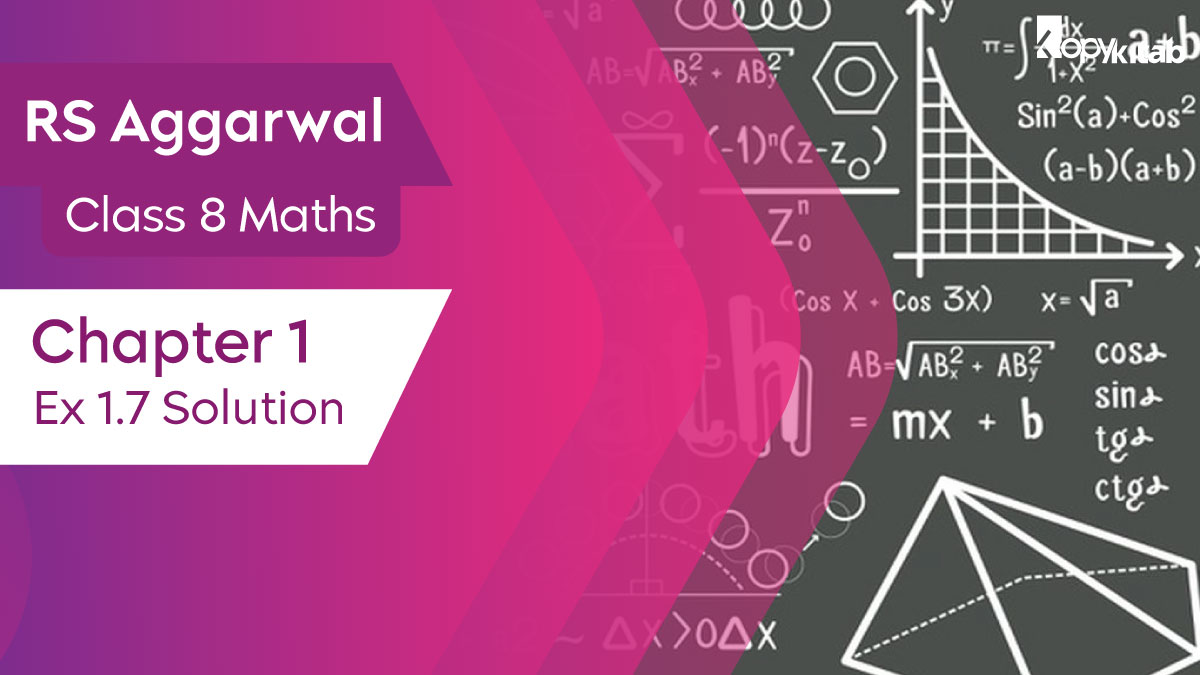
RS Aggarwal Class 8 Maths Chapter 1 Ex 1.7 Solutions – This exercise is based on the division of rational numbers & their properties. This set of solutions is solved by the Mathematics expert team to assist students to understand the fundamentals easily. These solutions help the students by providing them the elaborated answers for each question as per the latest CBSE marking scheme pattern. These solutions also assist the students to have a skillful studying pattern with which they can secure excellent marks in the Maths exam.
These solutions provide a detailed & in-depth understanding of each topic of the RS Aggarwal textbook. The students can make a study strategy for the final exam depending on their stronger & weaker areas & then can improve their performance by practicing RS Aggarwal Class 8 Maths Chapter 1 Ex 1.7 Solutions. The students will be able to grasp the topics correctly by practicing these solutions on a regular basis.
Access RS Aggarwal Class 8 Maths Chapter 1 Solutions PDF
Download RS Aggarwal Class 8 Maths Chapter 1 Ex 1.7 Solutions
RS Aggarwal Class 8 Maths Chapter 1 Rational Numbers Ex. 1.7 Solutions
Important Definition for RS Aggarwal Class 8 Maths Chapter 1 Ex 1.7 Solutions
- Division sign
A division sign is frequently displayed between 2 rational numbers & it shows that the first rational number needs to divide by the second rational number.
- Closure Property of Division of Rational Numbers
Rational Numbers are closed under Division except for 0. Consider 2 rational numbers a/b, c/d where c/d ≠ 0, (a/b ÷ c/d) is also a Rational Number.
For instance: 2/3 ÷ 4/5 = 2/3 x 5/4
= (2 x 5) / 3 x 4
= 10/12
Thus, 2/3 ÷ 4/5 & 10/12 is also a Rational Number.
- Commutative Property of Division of Rational Numbers
Division of Rational Numbers is not commutative. Assume 2 rational number a/b, c/d then a/b ÷ c/d ≠ c/d ÷ a/b
For instance:
1/4 ÷ 3/2 = 1/4 x 2/3
= 1 x 2/4 x 3 = 2/12
= 1/6
3/2 ÷ 1/4 = 3/2 x 4/1
= 3 x 4/2 x 1 = 12/2
= 6
Thus, 1/4 ÷ 3/2 ≠ 3/2 ÷ 1/4
Therefore, Commutative Property is not appropriate for Division.
- Associative Property of Division of Rational Numbers
Generally, the Division of Rational Numbers does not follow the Associative Property. Assume a/b, c/d, e/f be 3 Rational Numbers then a/b ÷ (c/d ÷ e/f) ≠ (a/b ÷ c/d) ÷ e/f
For instance:
2/5 ÷ (4/5 ÷ 1/9)
= 2/5 ÷ (4/5 x 9/1) = 2/5 ÷ (36/5) = 2/5 x 5/36
= 2 x 5/5 x 36 = 10/180 = 1/18
(2/5÷4/5) ÷ 1/9
= (2/5 x 5/4) ÷ 1/9 = (2 x 5/5 x 4) ÷ 1/9
= 10/20 ÷ 1/9 = 10/20 x 9/1
= 10 x 9/20 x 1 = 90/20 = 9/2
Therefore, 2/5 ÷ (4/5 ÷ 1/9) ≠ (2/5 ÷ 4/5) ÷ 1/9
- Property of 1 of Division of Rational Numbers
For every rational number a/b, we can have (a/b ÷ 1) = a/b
For instance: 12/5 ÷ 1 = 12/5
Property 1
For any non zero rational number a/b, we can have (a/b ÷ a/b) = 1
For instance: 3/4 ÷ 3/4
= 3/4 x 4/3
= 3 x 4/4 x 3
= 12/12 =1
Know more at the official website.
